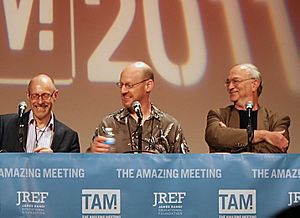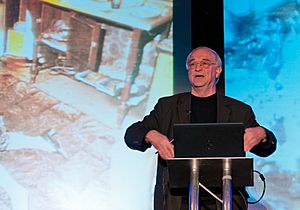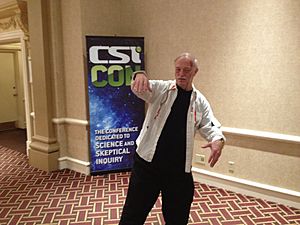Joe Nickell facts for kids
Quick facts for kids
Joe Nickell
|
|
|---|---|
Nickell in 2018
|
|
| Born |
Joe Herman Nickell
December 1, 1944 Lexington, Kentucky, U.S.
|
| Died | March 4, 2025 (aged 80) Buffalo, New York, U.S.
|
| Education | University of Kentucky (BA, MA, PhD) |
| Occupation |
|
| Known for | CSICOP |
Joe Herman Nickell (December 1, 1944 – March 4, 2025) was an American skeptic and investigator of the paranormal. This means he used science and logic to look into strange or unexplained events.
Nickell was a senior researcher for the Committee for Skeptical Inquiry. He wrote often for their magazine, Skeptical Inquirer. He was also a leader at the Center for Inquiry Institute. He wrote or helped write over 30 books.
Some of his important work included showing that the James Maybrick "Jack the Ripper Diary" was fake. In 2002, experts, including Nickell, checked a very old book called The Bondwoman's Narrative. This book might have been the first novel by an African-American woman. Nickell also studied documents about who wrote "The Night Before Christmas". He found evidence that supported Clement Clarke Moore as the author.
Contents
Early Life and Education
Joe Nickell was born in Lexington, Kentucky, on December 1, 1944. He grew up in West Liberty, Kentucky. His parents supported his interest in magic and solving mysteries. They even let him use a room in their house as a special lab for his investigations.
He earned his first college degree, a Bachelor of Arts (B.A.), in 1967 from the University of Kentucky.
In 1968, when he was 24, he moved to Canada to avoid military service. There, he started working as a magician, a card dealer, and a private investigator. He returned to the United States in 1977.
He went back to the University of Kentucky for more studies. He earned his Master of Arts (M.A.) in 1982 and his PhD in 1987. His PhD was in English, where he focused on how to investigate literature and folklore.
In 2006, Nickell married Diana G. Harris, who he had known since college. Diana helped him with his investigations. Nickell also wrote about how he learned he had an adult daughter. He used this experience to write an article about how people unconsciously gather information. He said, "It's enough to warm an old skeptic's heart."
Joe Nickell passed away in Buffalo, New York, on March 4, 2025, at the age of 80.
Joe Nickell's Career

Joe Nickell had many different jobs throughout his life. He worked as a stage magician, a carnival salesman, and a private detective. He was also a blackjack dealer, a riverboat manager, and a university teacher. Since the early 1980s, he wrote and edited many books.
A writer from The New Yorker magazine, Burkhard Bilger, wrote about Nickell. Bilger met Nickell in 2002 when Nickell was secretly investigating Spiritualist psychics.
Nickell was a regular guest on the Point of Inquiry podcast. He also led the yearly Houdini Seance at the Center for Inquiry every Halloween. News and TV shows often asked for his skeptical opinion on strange events.
Nickell explained his approach to investigations. He said he didn't like people who just dismissed things without looking into them. He believed it was important to study the history and culture of beliefs, even if he didn't think they were real.
He even helped actress Hilary Swank prepare for her role in the movie The Reaping (2007). In the film, she played a paranormal investigator.
Books by Joe Nickell
Nickell's books covered four main areas: religious mysteries, forensic science, paranormal events, and general mysteries. He also wrote books for young readers.
Investigating Religious Mysteries
Nickell investigated religious objects and claimed miracles. In his 1982 book, Inquest on the Shroud of Turin: Latest Scientific Findings, he showed how he gathered evidence. He then followed that evidence to reach a conclusion. He updated this book in 1998 with new information.
In his 1993 book, Looking for a Miracle: Weeping Icons, Relics, Stigmata, Visions and Healing Cures, Nickell looked at miracles claimed by different religions. He studied old writings and explored natural explanations. He also thought about why religious communities might believe in these events. He often concluded that the miracles were either hoaxes or misunderstandings of natural things.
For example, after studying a "weeping" St. Irene icon in Queens, New York, Nickell said:
The shiny surface and certain bumps made it look like it was weeping. A religious person wanting to see tears... could, especially with a candle, see glimmering in the tiny eyes. This was helped by vertical cracks and other marks, making it look like tears.
His 2007 book, Relics of the Christ, focused on Christian relics. He believed that honoring relics had become like worshiping idols. He said that no religious icon had ever been proven to have special powers. However, he always approached each case with an open mind, wanting to find the truth.
In 2008, Nickell wrote an introduction for John Calvin's Treatise on Relics. In his 2013 book, The Science of Miracles: Investigating the Incredible, Nickell used his investigative skills on 57 reported miracles. These included a Virgin Mary's face appearing on a grilled cheese sandwich. He presented facts and myths clearly and respectfully.
Forensic Science Investigations
Nickell's first book about checking if things are real was Pen, Ink, and Evidence. This book was about studying writing and writing materials. A reviewer praised Nickell's deep knowledge, calling it a "quiet passion."
In Camera Clues: A Handbook for Photographic Investigation, Nickell wrote about the history of photography. He showed how to figure out when old photos were taken. He also explained how fake old photos could be made and how to spot them. He described how police use photography and how trick photos are created.
Detecting Forgery: Forensic Investigation of Documents (1996) gave an overview of a document expert's work. He explained that fake documents are often revealed because the forgers don't know how to copy old typefaces, inks, or paper styles. Nickell discussed forgeries like Daniel Boone's musket and the Vinland Map.
Crime Science: Methods of Forensic Detection (1998) provided basic information about forensic science.
In Real or Fake: Studies in Authentication (2009), Nickell used his earlier work on paper, ink, and pens. He detailed his investigations into specific cases. These included the fake diary of Jack the Ripper and the real but unknown author of The Bondwoman's Narrative.
Investigating Paranormal Events

Secrets of the Supernatural was Nickell's first book about paranormal investigations. He and his co-author, John F. Fisher, looked for answers to mysteries like the Crystal Skulls and spontaneous human combustion. Nickell later explained that these mysteries keep being reported because each new generation hears about them for the first time.
Missing Pieces: How to Investigate Ghosts, UFOs, Psychics, and Other Mysteries was a guide for investigating the paranormal. Nickell often quoted Robert A. Baker, who said, "... there are no haunted places, only haunted people."
Mysterious Realms analyzed 10 common mysteries, including the Kennedy assassination and UFO cover-up theories.
In Psychic Sleuths: ESP and Sensational Cases, Nickell gathered reports from researchers who investigated claims of psychic detectives. He concluded that these psychics were either fooling themselves or others.
Entities: Angels, Spirits, Demons, and Other Alien Beings showed how ghost stories have changed over time. He explained how new technology, like cameras, influenced stories such as the faked Cottingley Fairies photographs.
Adventures in Paranormal Investigation was a more detailed book. It covered topics from dowsing to healing spas.
The first part of CSI Paranormal is a guide on how to investigate paranormal claims. Nickell shared his step-by-step strategy. This included investigating on site, checking details, researching past cases, and trying to recreate "impossible" events. The second part showed how he used this strategy on cases like the Roswell UFO and the grilled cheese Madonna.
In The Science of Ghosts (2012), Nickell looked at common ghost stories. He showed that these stories are not proof of spirits. Instead, they show how a certain setting can affect people who are open to believing. He also analyzed modern paranormal investigators.
Solving Historical Mysteries
Ambrose Bierce Is Missing And Other Historical Mysteries was Nickell's 1992 book about historical investigations. He used legal ideas like "a preponderance of the evidence" to measure how likely an explanation was. His updated 2005 version, Unsolved History: Investigating Mysteries of the Past, was similar.
Real-Life X-Files and The Mystery Chronicle were collections of short essays. They covered the history and likely causes of many mysteries. Nickell sometimes recreated legends to show that no special powers were needed to copy the effects. For example, he and his family created a large condor shape in a field. He believed this showed how the Nazca Lines in Peru could have been made. He also investigated West Virginia's Mothman. He interviewed witnesses and did experiments. He found that people likely mistook an owl, probably a Barred owl, for the Mothman.
Secrets of Sideshows was called an "encyclopedia" of old-fashioned sideshow entertainment.
Lake Monster Mysteries: Investigating the World's Most Elusive Creatures was written with Ben Radford. Nickell suggested that many lake monster sightings could be explained by groups of otters swimming in a line. He said, "I've spoken to people who saw what they thought was a lake monster, got closer and discovered it was actually a line of otters. That really happens."
For Tracking the Man-Beasts: Sasquatch, Vampires, Zombies, and More, Nickell traveled to many places where monsters were reported. He looked into Bigfoot in the Pacific Northwest and vampires in New England. He concluded that these stories change over time, reflecting culture, not real creatures. A guide in the Louisiana swamps told him that scary tales were sometimes made up to keep outsiders away.
Books for Young Readers
In 1989, Nickell wrote The Magic Detectives: Join Them in Solving Strange Mysteries. This book presented paranormal stories as mysteries for children to solve. The answers were printed upside down after each story.
His 1991 book, Wonder Workers! How They Perform the Impossible, was a biographical tour of famous magicians. It explained how they did their tricks.
Investigating UFOs
In 1997, Nickell, along with Kendrick Frazier and Barry Karr, published The UFO Invasion. This book was a collection of articles about UFOs from the Skeptical Inquirer magazine. It covered everything from UFO history to Roswell and crop circles. Nickell explained that stories of alien abductions might come from powerful waking dreams or hypnosis. He also noted how alien descriptions have changed over time. He said, "We tend to make the various entities that we're interested in in our own image."
Other Investigations
The Shroud of Turin
The Shroud of Turin is a famous cloth believed by some to be the burial cloth of Jesus. It supposedly has an image of his crucified body. The Roman Catholic Church owns the Shroud but does not officially say if it is real. Nickell and others believed the Shroud was a 14th-century painting. This idea was supported by radiocarbon dating in 1988. Nickell pointed out that the face and body on the Shroud look like figures from Gothic artists of that time, not a real person. He also created a believable copy of the Shroud using methods that could have been used in the 14th century.
Nickell said, "People assume it was about religion. ... For us it was not a religious issue, it was a matter of evidence. ... You want people to be precisely correct about evidence. Details matter."
The Warrens
Nickell did not like being called a "debunker." However, his investigations of paranormal events never found any real miracles, ghosts, or monsters. His focus on facts led to a strong disagreement with Ed and Lorraine Warren on a TV show in 1992. Nickell believed the Warrens were exploiting people. He said, "I've investigated haunted houses for some twenty years. I've not met a house that I thought was haunted; I think the Warrens have not met a house they didn't think was haunted." He pointed out that the Warrens often convinced people that demons were involved, especially in Catholic families, and then wrote books about it.
Aliens
Nickell suggested that alien encounters are often due to people misinterpreting natural events, hoaxes, or having a very active imagination. He explained how alien descriptions have changed over the years. He said that early aliens were "little green men." But after the Betty and Barney Hill case, the "big-eyed, big-headed humanoid" became the standard. He noted that aliens often look like us, just as Bigfoot is seen as a "big, stupid cousin" and ET as a "futuristic relative."
Magazine Articles and Website Blogs
Nickell wrote a column called "Investigative Files" for Skeptical Inquirer (SI) magazine from 1995 until his death. He also wrote often for the Center for Inquiry website. His articles covered many topics, including spontaneous human combustion, ghost photos, reincarnation, voodoo, Bigfoot, and psychic frauds. In an article about the Bell Witch Poltergeist, Nickell studied the writing style of the alleged original author and the reporter who expanded the story. He concluded that the reporter likely wrote the "Bell" manuscript.
Nickell also wrote "Nickell-odeon Reviews" for the Center for Inquiry website. These reviews focused on the facts behind movie plots. For example, he added details to the movie The Invisible Woman, explaining how infrared photography helped scholars read hidden parts of Dickens' letters.
Awards and Recognition
Joe Nickell received several awards for his work. In 2004, he got the Isaac Asimov Award from the American Humanist Association. He also shared the Robert P. Balles Prize in Critical thinking in 2005 and 2012. In 2000, he was given the Distinguished Skeptic award from CSI.
He also received an award for promoting science in popular media in 2009.
In October 2011, an asteroid was named JoeNickell in his honor by its discoverer, James E. McGaha.
Major Works
- Inquest on the Shroud of Turin: Latest Scientific Findings (1983, revised 1998)
- Secrets of the Supernatural: Investigating the World's Occult Mysteries (1988, 1991; with John F. Fischer)
- The Magic Detectives: Join Them in Solving Strange Mysteries (1989)
- Pen, Ink, and Evidence: A Study of Writing and Writing Materials for the Penman, Collector, and Document Detective (1990, 2000, 2003)
- Wonder-Workers! How They Perform the Impossible (1991)
- Unsolved History: Investigating Mysteries of the Past (1992, 2005)
- Missing Pieces: How to Investigate Ghosts, UFOs, Psychics, and Other Mysteries (1992; with Robert A. Baker)
- Mysterious Realms: Probing Paranormal, Historical, and Forensic Enigmas (1992; with John F. Fischer)
- Looking for a Miracle: Weeping Icons, Relics, Stigmata, Visions and Healing Cures (1993, 1998)
- Psychic Sleuths: ESP and Sensational Cases (1994)
- Camera Clues: A Handbook for Photographic Investigation (1994, 2005)
- Entities: Angels, Spirits, Demons, and Other Alien Beings (1995)
- Detecting Forgery: Forensic Investigation of Documents (1996, 2005)
- The Outer Edge: Classic Investigations of the Paranormal (1996, co-edited with Barry Karr and Tom Genoni)
- The UFO Invasion: The Roswell Incident, Alien Abductions, and Government Coverups (1997; co-edited with Kendrick Frazier and Barry Karr)
- Crime Science: Methods of Forensic Detection (1999; with co-author John F. Fischer)
- Real-Life X-Files: Investigating the Paranormal (2001)
- The Kentucky Mint Julep (2003)
- Investigating the Paranormal (2004)
- The Mystery Chronicles: More Real-Life X-Files (2004)
- Secrets of the Sideshows (2005)
- Cronache del Misterio (2006)
- Lake Monster Mysteries: Investigating the World's Most Elusive Creatures (2006; with co-author Benjamin Radford)
- Relics of the Christ (2007)
- Adventures in Paranormal Investigation (2007)
- Tracking The Man-Beasts: Sasquatch, Vampires, Zombies, and More (2011)
- Real or Fake: Studies in Authentication (2009)
- CSI Paranormal (2012)
- The Science of Ghosts (2012)
- The Science of Miracles: Investigating the Incredible (2013)
See also




